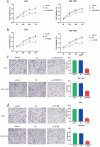Identification and Validation of Prognostic Markers for Endometriosis-Associated Ovarian Cancer
- PMID: 39113897
- PMCID: PMC11302560
- DOI: 10.7150/ijms.97024
Identification and Validation of Prognostic Markers for Endometriosis-Associated Ovarian Cancer
Abstract
Background: Growing evidence suggests that endometriosis (EMs) is a risk factor for endometriosis-associated ovarian cancer (EAOC). The aim was to identify and validate gene signatures associated with EMs that may serve as potential biomarkers for evaluating the prognosis of patients with EAOC. Methods: The data of EMs and control samples was obtained from GEO database. The weighted gene co-expression network analysis (WGCNA) identified modular genes significantly associated with EMs. The KEGG pathway and GO functional enrichment analyses were also performed. Univariate Cox regression analysis was conducted to screen marker genes associated with the prognosis of EAOC patients. Finally, RT-qPCR and immunohistochemical verified the expression of ADAMTS19 and TUBB in normal ovarian and EAOC tissues, and the biological functions of ADAMTS19 and TUBB were preliminarily explored by CCK8 and Transwell assays. Results: The WGCNA identified 2 co-expression modules, which in total included 615 genes, and 7642 differentially expressed genes (DEGs) were detected thorough analysis of the EAOC dataset. After taking the intersection of 615 modular genes and 7642 DEGs, 214 shared genes were obtained, and univariate COX regression analysis pointed 10 genes associated with the prognosis of EAOC. Moreover, it was demonstrated by RT-qPCR and immunohistochemical staining experiments that ADAMTS19 expression was elevated, while TUBB expression was reduced in EAOC compared with normal ovarian cells and tissues. Finally, cell experiments revealed that ADAMTS19 promoted the proliferation and invasion in EAOC cells, while overexpression of TUBB inhibited these processes. Conclusions: The present study identified and validated new EMs-associated gene markers, which could serve as potential biomarkers for assessing the prognostic risk of EAOC patients. In addition, some of these genes may have significance as novel therapeutic targets and could be used to guide clinical applications.
Keywords: ADAMTS19; Endometriosis; Endometriosis-Associated Ovarian Cancer; Prognosis; TUBB.
© The author(s).
Conflict of interest statement
Competing Interests: The authors have declared that no competing interest exists.
Figures








Similar articles
-
The expression of autophagy-related gene CXCL12 in endometriosis associated ovarian cancer and pan-cancer analysis.Front Endocrinol (Lausanne). 2025 Mar 17;16:1450892. doi: 10.3389/fendo.2025.1450892. eCollection 2025. Front Endocrinol (Lausanne). 2025. PMID: 40166682 Free PMC article.
-
Plasma microRNAs as novel biomarkers for endometriosis and endometriosis-associated ovarian cancer.Clin Cancer Res. 2013 Mar 1;19(5):1213-24. doi: 10.1158/1078-0432.CCR-12-2726. Epub 2013 Jan 29. Clin Cancer Res. 2013. PMID: 23362326 Free PMC article. Clinical Trial.
-
Aberrant expression of genes associated with stemness and cancer in endometria and endometrioma in a subset of women with endometriosis.Hum Reprod. 2018 Oct 1;33(10):1924-1938. doi: 10.1093/humrep/dey241. Hum Reprod. 2018. PMID: 30020448
-
Evidence for the Relationship Between Endometriosis and Epithelial Ovarian Cancer.Obstet Gynecol Surv. 2015 Sep;70(9):587-95. doi: 10.1097/OGX.0000000000000218. Obstet Gynecol Surv. 2015. PMID: 26403563 Review.
-
Integrating modern approaches to pathogenetic concepts of malignant transformation of endometriosis.Oncol Rep. 2019 Mar;41(3):1729-1738. doi: 10.3892/or.2018.6946. Epub 2018 Dec 21. Oncol Rep. 2019. PMID: 30592289 Review.
Cited by
-
New Evidence About Malignant Transformation of Endometriosis-A Systematic Review.J Clin Med. 2025 Apr 25;14(9):2975. doi: 10.3390/jcm14092975. J Clin Med. 2025. PMID: 40364006 Free PMC article. Review.
-
Infection characteristics and risk factors in ovarian cancer patients with concomitant vaginitis.Am J Transl Res. 2025 Apr 15;17(4):2927-2936. doi: 10.62347/UPWG5358. eCollection 2025. Am J Transl Res. 2025. PMID: 40385009 Free PMC article.
References
-
- Kok VC, Tsai HJ, Su CF, Lee CK. The Risks for Ovarian, Endometrial, Breast, Colorectal, and Other Cancers in Women With Newly Diagnosed Endometriosis or Adenomyosis: A Population-Based Study. Int J Gynecol Cancer. 2015;25:968–76. - PubMed
-
- Herreros-Villanueva M, Chen CC, Tsai EM, Er TK. Endometriosis-associated ovarian cancer: What have we learned so far? Clin Chim Acta. 2019;493:63–72. - PubMed
-
- Králíčková M, Laganà AS, Ghezzi F, Vetvicka V. Endometriosis and risk of ovarian cancer: what do we know? Arch Gynecol Obstet. 2020;301:1–10. - PubMed
-
- Kobayashi H, Sumimoto K, Kitanaka T, Yamada Y, Sado T, Sakata M. et al. Ovarian endometrioma-risks factors of ovarian cancer development. Eur J Obstet Gynecol Reprod Biol. 2008;138:187–93. - PubMed
MeSH terms
Substances
LinkOut - more resources
Full Text Sources
Medical
Research Materials

